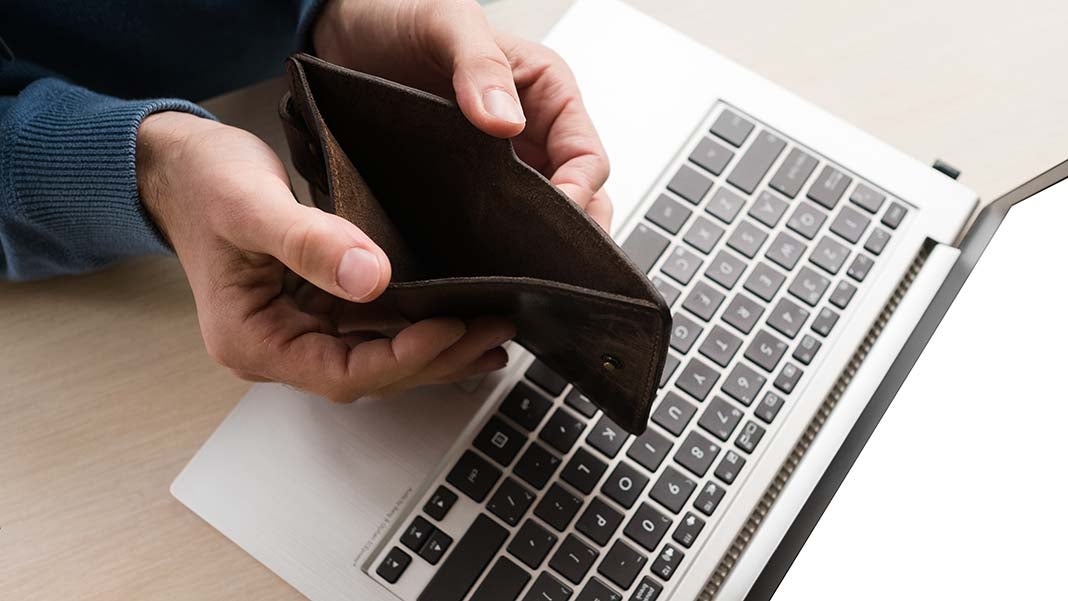
It’s no secret that running a business is tough. You knew it long before you even started down this path. You’ve heard all the stats before—over 20% of all small businesses fail within the first year, and more than half don’t make it to five years—and everyone you spend any time with at all feels like it’s their responsibility to inform you of these statistics.
As annoying as they are, these not-so-subtle warnings from nosy acquaintances should resonate with you and serve as cautionary anecdotes for your burgeoning business. They are artefacts of the public psyche left by local news reports and first-hand experiences of witnessing businesses close their doors within their first years of operation.
You get it. Small businesses fail.
But one thing you may not know is why these businesses fail so early on. Although individual reasons vary, the vast majority of small businesses that fail do so because they experience cash-flow problems.
Cash flow is the money that moves in and out of your business. Most outgoing flows are somewhat fixed—expenses, rent, and utility and loan payments. Incoming flows tend to be more variable, as they are less likely to be automated and rely more on different people making payments at different times.
A business will experience cash-flow problems if the incoming flow is smaller than the outgoing flow, or—perhaps even more frustrating—if there is an imbalance in finances due to customers making late payments.
Considering the fact that over 25% of all invoices are paid late, the issue is quite common, and likely one your business will experience at some point.
It seems like such a preventable problem, yet so many small businesses, freelancers, and contractors struggle to cope with the financial strains placed on them by negligent customers and needlessly late payments.
So how can you avoid a similar fate to all those failed small businesses we keep hearing about?
Below, we’ve compiled a list of seven simple ways you can ensure you get paid on time and avoid running into any devastating cash-flow problems.
1. Do Your Homework
Nothing will affect your chances of being subject to late payments more than the history of your clients. As the old adage goes, a leopard can’t change its spots, and you’ll find that deadbeat customers tend to remain set in their ways. If they’ve been late in the past, they’ll probably be late again.
Serial offenders will have left a raft of unhappy business owners and contractors in their wakes, and fortunately, you can usually see them coming from miles away—if you know how to look.
Before agreeing to do any work for a prospective client, do some digging into their track record and payment history with other small businesses, freelancers, and contractors. Google their name and look for any red flags that may pop up.
If other businesses like yourself have had problems with them before, there’s probably evidence of it online. They will likely have left a noticeable footprint on the consumer reviews section at the Better Business Bureau, their Facebook page, or their own personal website.
Remember, your time and services are valuable, and should not be wasted on problematic customers. It’s ok to turn down prospective jobs and clients—especially if there’s the potential for them to unbalance your books. Do your homework first, and avoid becoming part of the failed businesses statistic by sticking to clients you can trust to pay you on time.
2. Raise Your Prices
As a growing small business, the idea of raising your prices may seem counterintuitive. Surely, as a relative unknown and newcomer to the market, you want your prices to be cheaper than or at least comparable to those of your competitors, right?
Not necessarily.
Keeping your prices relatively high will make your products or services appear to be of higher quality than the rest of the field. It will also help to weed out the aforementioned deadbeat customers, as they will always be looking for the cheapest way to get what they want.
Consider the stereotypical differences (fair or not) between Walmart and Target customers. Although the two stores sell very similar—if not the same—products, Walmart’s prices tend to be cheaper, and thus, tend to attract a certain type of clientele. Put simply, the cheaper your prices are, the cheaper your clients are likely going to be.
Cheaper clients will mean late payments, requests for discounts or extensions, attempts at bartering, ghosting, or any of a myriad of other tricks and gambits.
As bad as these things sound, you can avoid the situation entirely by raising your prices to target a higher, more reliable tier of customer. You may miss out on some opportunities as a result, but the gains you make from the increased profit margin and improved clientele—not to mention avoiding the whole late payment merry-go-round—will make the gamble worth it in the long run for the sustainability and longevity of your business.
3. Don’t Wait to Send Your Invoice
Late payments are sometimes simply the result of your customer receiving the invoice when they are busy doing other things, or it getting buried in a sea of emails.
We’ve all had this experience at one point or another—you’re on the go and you receive an important email, but then you receive another, and another, and soon, the important email becomes inadvertently forgotten.
One of the keys to receiving prompt payment and avoiding a situation in which your invoice is buried and forgotten is to send it promptly after the job has been completed, while it’s still fresh in your client’s mind. That way, it will be treated as more of a traditional transaction – where a customer receives a product or service and then immediately pays for it—and one in which you’re likely to receive payment faster.
An additional strategy you can employ to encourage on-time payments is to hasten the due date of your invoice. Again, it may seem counterintuitive, but shortening the time period in which customers can pay their invoices actually tends to encourage prompt payments.
Think about it this way: when do you do your taxes? Everyone knows that taxes are due by April 15, but when do you do them? If you’re like roughly 28% of Americans, you wait until the month of April to file—three or four months after the earliest possible date for a given year. And even then, many request an extension which allows them to file in October!
The point is, you can reduce procrastination and help to ensure you get paid on time by not only sending your invoices promptly, but also by reducing the timeframe in which your clients can pay. We recommend setting your due date seven days out, and no later than 14 days out.
4. Make it Easy for Clients to Pay
It’s 2018, and people want things to be convenient and easy. From buying plane tickets online and ridesharing apps, to having meals and groceries delivered right to our doors, we’ve become accustomed to things being easy and contained within the palms of our hands.
Things that are not fast and easy—for example, returning an unwanted item to the store—we tend to procrastinate and set aside for a time when it’s more convenient for us.
The same logic can be applied to your invoices.
If the invoice you provide requires your clients to go to the bank to complete a wire transfer or, worse yet, pay you in person, you’re just asking for procrastination and late payments.
Consider setting up a method by which your customers can pay you online, from the comfort of their homes or the convenience of their phones. This way, all they will need to do is enter their names and a few digits, and voila! You’ll get paid quickly, easily, and on time.
Additionally, it’s important that your clients understand exactly how to pay. If you make them manually type in a long URL, or go through a shady payment gateway with unclear instructions, they will undoubtedly be less likely to pay you—let alone on time.
Luckily, there are free invoice apps online that can help in both of these areas. These apps allow you to not only enable online payments with various payment processors from right within the interface, but also provide easy means for your customers to do so.
By setting up a way for your clients to pay online – be it using an invoicing app or simply a payment gateway like PayPal—you take the hassle out of the process and make it easy for them to pay on time.
5. Offer Incentives for Early Payments
There are few greater motivators than the almighty dollar. People will do almost anything to save a buck here and there, as poignantly demonstrated by the annual madness that is Black Friday.
As the owner of a small business—contractors and freelancers included—you are in a unique position to adjust your prices as you see fit and take advantage of people’s willingness to go out of their way to save money.
Consider offering a discount for payments made within the first two-to-three days of receiving an invoice. A discount of even 10% will get your clients moving and encourage them to pay on time. And if you’ve followed tip number two from this article, your prices will already be a little higher than necessary, allowing you to reduce them to a standard price for the discount.
This means you will still be making money, while also incentivizing your customers into paying you on time.
Alternatively, you can penalize delinquent customers with late fees for past-due payments. This strategy is a bit trickier, however, as you will have to very clearly and conspicuously establish these terms beforehand with your clients. Any unexpected charges are sure to anger your customers and might land you a bad review with the Better Business Bureau, among other places.
Whichever course of action you decide to take, remember that money talks, and by implementing discounts or penalties, you will surely reduce the likelihood of late payments.
6. Exude Professionalism
Treat others the way you want to be treated.
What goes around comes around.
Be the change you want to see in the world.
There are countless well-known quotes to this effect, and you’ve probably heard them all. Regardless of how you repackage them, the message is the same—the people you interact with tend to mirror your own demeanor and way of treating others.
Needless to say, this same concept can and should be applied to your business.
Conducting your business in a professional demeanor will encourage professionalism from your clients. This includes every aspect of your business, from how you conduct yourself in your emails and other communications, to your punctuality and how well you actually do the job.
Of course, any lapse in professionalism on your end will likely allow for some lapses on the client’s side, so it’s important to maintain this impression of reliability and dedication—which includes how you handle your invoicing.
Go Digital
It probably goes without saying, but it’s 2018, and handwritten, pen-and-paper invoices seem sloppy and convey an air of disorganization. Try using one of the many invoice software packages found online. They will ensure you that you are always organized, and that your invoices look professional and (most importantly) legible.
Alternatively, you can download free, premade invoice templates online and tailor them to your own business needs. This solution is fast, easy, and maintains that air of professionalism that will encourage your clients to follow suit—and ultimately, pay their invoices on time.
Use a Professional Email
Another strategy you can employ to increase your image of professionalism is to set up an “accounts” email address (e.g. accounts@yourbusiness.com). This strategy will give your clients the impression that they are not dealing with one individual, but rather, an automated billing system.
There is no reasoning or haggling with an automated system, and your clients will be much less likely to make late payments to an accounts email address than they would, say, a jim@abcdesigns.com-type email.
Get Terms in Writing
Finally, when you envision the word “professionalism,” what do you see? Suits and ties, briefcases, boardrooms, and contracts probably come to mind. Depending on the type of work you do, suits, briefcases, and boardrooms are likely unnecessary, impractical, and prohibitively expensive (looking at you, boardrooms).
However, contracts and written agreements are also key to our interpretations of what it means to be professional, and they are necessary for successfully running a business. Establishing your terms and invoice due date clearly, before any of the work has started, will lay down a precedent for your clients and demonstrate that you take your business seriously.
Having already seen and agreed to your terms and dates early on, your customers will be much more likely to follow through on their end and make their payments on time.
While the Golden Rule may seem like it was pulled straight from a cat poster at the dentist, it’s one that can be leveraged to your advantage and help you receive your hard-earned money in a timely manner.
7. Don’t Be Shy
As a one-man show—be it as freelancer, contractor, or entrepreneur—it’s easy to get caught up worrying about coming across as rude, or taking minor issues personally.
It’s important to remember that business is business, and requesting that your payment be made within the agreed-upon timeframe is not a personal issue. You have done the work, and the money is something that is owed to you.
It’s not rude to request payment, send reminders if the due date is approaching, or make phone calls to recoup payments for past-due invoices.
Don’t let the fear of losing your customer prevent you from taking steps to obtain payment. If they are the type that will let an invoice become overdue, then get upset with you for kindly reminding them to pay, then they are not the type of customer you want to have repeat business from anyway.
Consider writing a standardized reminder email template that you can use for all customers who fail to make their payments on time. This way, you can fire off the same email whenever the situation arises, and not get caught frantically writing up an email in the moment, when your frustration may show through your words. You can also type up a script for what you will say verbally if you have to pick up the phone and make a call.
Additionally, if you set up an “accounts” email, as outlined above in tip number six, you will create a degree of separation between you and the customer. This will be extremely helpful in the event that there is a late payment or dispute. Your clients will not feel singled out by you, but rather, that your billing system has automatically sent them a reminder.
At the end of the day, keeping your customers happy is vital, but expecting and holding them to the basic guidelines for commerce that have been in place for thousands of years is not unreasonable. Don’t be shy, and take active steps to recoup the money you deserve for your hard work.
Conclusion
For such an unnecessary and unpredictable problem, late payments can have a profound effect on your cash flow. They are the thorn in the side of any up-and-coming small business, and if rampant enough, have the potential to completely devastate businesses of all sizes.
Luckily, there are steps you can take to encourage your clients to make timely payments, and help avoid any cash flow issues stemming from outstanding accounts.
The keys to any business venture are professionalism and respect. By aligning your invoicing tools, practices, and attitude with these ideals, you can ensure that customers also treat your enterprise with the respect that your hard work demands.
3485 Views












